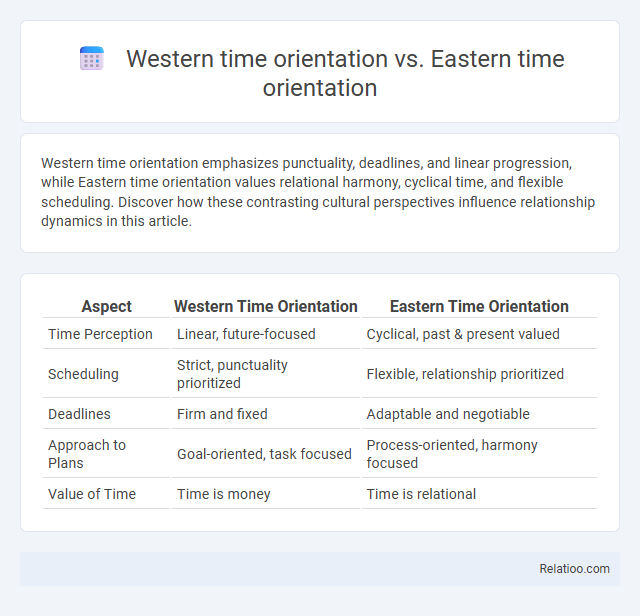Western time orientation emphasizes punctuality, deadlines, and linear progression, while Eastern time orientation values relational harmony, cyclical time, and flexible scheduling. Discover how these contrasting cultural perspectives influence relationship dynamics in this article.
Table of Comparison
| Aspect | Western Time Orientation | Eastern Time Orientation |
|---|---|---|
| Time Perception | Linear, future-focused | Cyclical, past & present valued |
| Scheduling | Strict, punctuality prioritized | Flexible, relationship prioritized |
| Deadlines | Firm and fixed | Adaptable and negotiable |
| Approach to Plans | Goal-oriented, task focused | Process-oriented, harmony focused |
| Value of Time | Time is money | Time is relational |
Introduction to Time Orientation
Time orientation refers to how cultures perceive and value time, influencing behavior and decision-making. Western time orientation typically emphasizes punctuality, linear progression, and future planning, prioritizing schedules and deadlines. Eastern time orientation often values flexibility, cyclical understanding of time, and present relationships, focusing on harmony and process over strict adherence to time constraints.
Defining Western Time Orientation
Western time orientation emphasizes strict schedules, punctuality, and a linear progression of time, prioritizing efficiency and deadlines. In contrast, Eastern time orientation often views time cyclically, valuing relationships and flexibility over rigid adherence to the clock. Your understanding of these differences can enhance cross-cultural communication and improve project management in global settings.
Defining Eastern Time Orientation
Eastern time orientation emphasizes relationships, flexibility, and the present moment, valuing harmony and collective well-being over strict adherence to schedules. In contrast, Western time orientation prioritizes punctuality, deadlines, and linear progress, focusing on efficiency and individual achievement. Understanding these differences helps you navigate cross-cultural interactions by appreciating the Eastern perspective's fluid approach to time and social context.
Historical Roots of Time Perception
Western time orientation is largely linear, rooted in Judeo-Christian traditions emphasizing progress and future goals, while Eastern time orientation reflects cyclical views influenced by Hinduism and Buddhism, focusing on harmony and continuity. Historical roots of time perception shape cultural attitudes toward punctuality, planning, and value systems, with Western cultures often prioritizing deadlines and efficiency compared to Eastern cultures' emphasis on patience and relational timing. These divergent time orientations impact social behavior, business practices, and interpersonal communication globally.
Linear vs Cyclical Time Concepts
Western time orientation predominantly follows a linear time concept, emphasizing schedules, deadlines, and a sequential progression from past to future. Eastern time orientation often embraces a cyclical time perspective, viewing time as recurring patterns and natural rhythms that influence life and events. Understanding these differences in time orientation can help you navigate cultural expectations and improve communication across diverse contexts.
Impact on Daily Life and Scheduling
Western time orientation emphasizes punctuality, strict schedules, and linear progress, influencing daily life by prioritizing efficiency and deadlines in work and social settings. Eastern time orientation often adopts a more flexible, cyclical approach to time, valuing relationships and context over rigid schedules, which impacts daily routines by allowing adaptability and relational harmony. Understanding these divergent time orientations helps in managing cross-cultural scheduling, reducing conflicts, and fostering effective communication in global environments.
Business Implications and Work Culture
Western time orientation emphasizes punctuality, strict schedules, and deadlines, fostering a results-driven business culture with a focus on efficiency and productivity. Eastern time orientation often values flexibility, relationship-building, and long-term planning, encouraging a collaborative work environment and patience in decision-making processes. Understanding these differences in time orientation is crucial for multinational companies to navigate cross-cultural negotiations, optimize teamwork, and align project timelines effectively.
Communication Styles and Time
Western time orientation emphasizes punctuality, deadlines, and a linear approach to time, influencing communication styles to be direct, concise, and task-focused. Eastern time orientation often values flexibility and relational harmony, resulting in communication that is more indirect, context-driven, and respectful of social hierarchies. Your understanding of these time orientations can enhance cross-cultural communication by tailoring your approach to either prioritize efficiency or relationship-building based on the cultural context.
Challenges in Cross-Cultural Interactions
Western time orientation emphasizes punctuality, schedules, and efficiency, often perceiving time as linear and segmented. Eastern time orientation typically views time as cyclical and flexible, prioritizing relationships and context over strict adherence to deadlines. Your ability to navigate these contrasting perspectives is crucial for overcoming misunderstandings and fostering effective communication in cross-cultural interactions.
Bridging the Gap: Fostering Mutual Understanding
Western time orientation emphasizes punctuality, deadlines, and efficiency, often viewing time as a linear resource to be managed. Eastern time orientation tends to prioritize relationships, flexibility, and cyclical patterns, perceiving time as a fluid and interconnected flow. Bridging the gap requires fostering mutual understanding by appreciating diverse temporal perceptions, encouraging open communication, and adapting strategies to respect both linear and flexible time frameworks.

Infographic: Western time orientation vs Eastern time orientation
 relatioo.com
relatioo.com